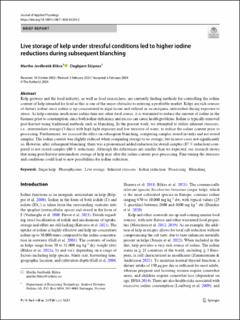| dc.description.abstract | Kelp growers and the food industry, as well as food researchers, are currently finding methods for controlling the iodine content of kelp intended for food as this is one of the major obstacles to entering a profitable market. Kelps are rich sources of dietary iodine since iodine is up-concentrated in algal tissue and utilized as an inorganic antioxidant during exposure to stress. As kelp contains much more iodine than any other food source, it is warranted to reduce the amount of iodine in the biomass prior to consumption, since both iodine deficiency and excess can cause health problems. Iodine is typically removed post-harvest using traditional methods such as blanching. In the present work, we attempted to utilize inherent stressors, i.e., intermediate storage (3 days) with high light exposure and low turnover of water, to reduce the iodine content prior to processing. Furthermore, we assessed the effect on subsequent blanching, comparing samples stored in tanks and not stored samples. The iodine content was slightly reduced when comparing storage to no storage, but in most cases not significantly so. However, after subsequent blanching, there was a pronounced added reduction for stored samples (87 % reduction) compared to not stored samples (80 % reduction). Although the differences are smaller than we expected, our research shows that using post-harvest intermediate storage of kelp may alter the iodine content post-processing. Fine-tuning the stressors and conditions could lead to new possibilities for iodine reduction. | |
